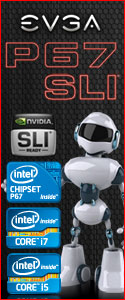As mentioned at the beginning of the review, the K2 part number comes with the ECP Front Panel and the EVGuage as added accessories. We installed both of these to our Corsair 700D (with an 800D windowed panel) so you can get an idea of what they look like. Even if you purchase the package that comes without these two toys, they are available for purchase from EVGA’s web site. There is one small problem with the ECP Front Panel, the screws needed to mount it in a 5.25 bay are not included at this time. Normally this would not be an issue as most of us have plenty of PC screws laying around, however these screws are not a normal size. So for now, plan on a trip to your local hardware store to pick up some 2.5mm thread size screws. We found that any length from 5mm to 10mm will work fine in most cases. EVGA has stated that the screws were supposed to be packaged with the ECP Front Panel and will be in the future.
The ECP Front panel has a LED display that will either show the CPU temp once in windows, or if you turn that function off in BIOS it will only show the post codes. Either setting will cycle through the post codes as the system boots up. It’s basically displaying exactly what your on-board LED display is showing. The top row of three buttons feature two vCore and one VCCSA voltage adjustment options. Each vCore button, when pressed, will raise the voltage by 0.1v, or by pressing both buttons you can get a 0.2v raise in vCore. By pressing the VCCSA button you will get a 0.1v increase for that voltage. Below the voltage adjustment buttons is a second row of buttons which are used to disable the various PCI-e video card slots for troubleshooting any GPU card problems you may be experiencing.
The EVGuage is a throwback to analogue style meters. After plugging the cable to the header on the motherboard, which is located just above the PCI-ex1 slot, simply start the system and the needle will rise to coincide with your CPU speed. Not the most useful accessory ever invented but certainly unique to EVGA and pretty cool looking as well.
Finally we’ll toss out a picture of the system built into the Corsair 700D, water cooled and ready for some serious overclocking and gaming action!
The P67 FTW impressed us from the minute we took it out of the box. The black and red color scheme looks terrific when coupled with a case that has a black painted interior, which is almost standard fare on cases with a black exterior now days. The P67 FTW took everything we could throw at it without so much as a whimper and seemed to beg for more, which we will surely provide when time permits! Overclocking this board was about as easy as it gets, and just plain works.
It’s well known that EVGA was late to market with their P67 offerings, but we’ll simply say that the wait was clearly worth it.
Pros
- Great looks
- UEFI Bios
- Replaceable BIOS chip
- Large assortment of accessories
- Triple BIOS
- 12-Phase PWM
- 100% Solid State Capacitors
- Voltage read-out points
- Dual 8-Pin CPU Power Connectors
- On-Board Power/Reset/CLRCMOS switches
Cons
- ECP Front Panel screws not packaged/odd size
- Users Manual not very detailed
- Front panel case wires are a tight fit under long video cards
The P67 FTW sells for anywhere between $249.00 to $269.00 depending on your choice of buying with or without the ECP Front panel and EVGuage. That price puts it at the upper end of available P67 motherboard options on the market. However, with the performance, looks and overclocking prowess the P67 FTW offers, the price is well justified in our opinion. You will be hard pressed to find another P67 motherboard out there that can out perform the P67 FTW. If you are looking to jump in to the Sandy Bridge platform and want a motherboard that will look great, overclock even better and give you the features you need, then the EVGA P67 FTW needs to be at the top of your list!
EVGA’s P67 FTW has earned a score of 9.5/10 and the accompanying Gold Award! A recommended must buy product!





 Posted in
Posted in 





